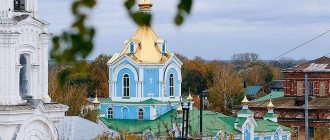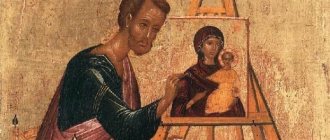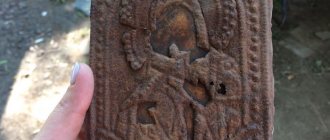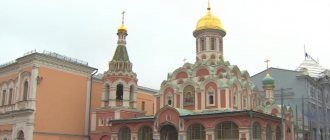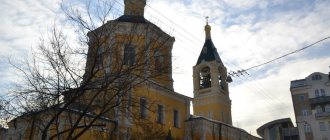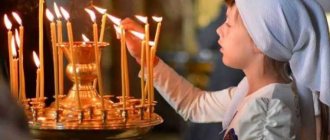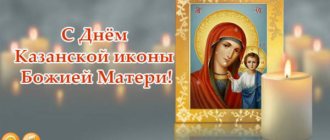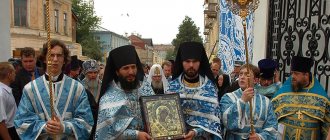Address: B. Krasnaya st., 5
One of the most famous Orthodox places in Kazan, which both religious pilgrims and curious tourists strive to visit, is the complex of the Kazan Bogoroditsky Monastery, which is located very close to the Kazan Kremlin.
- Kazan Cathedral
The architectural buildings of this well-known monastery attract, first of all, their history associated with the acquisition of one of the most revered Russian Orthodox icons - the Icon of Our Lady of Kazan
.
One of the most famous monasteries in Kazan is the Bogoroditsky Monastery
Kazan Bogoroditsky Monastery
The memorable date of the appearance of the icon, as well as the founding of the monastery, is 1579.
At this time, the eastern part of Kazan suffered from a large fire and an image was found in the field of one of the courtyards. According to legend, the Mother of God herself informed people about the location of the shrine, appearing three times in a dream to a 12-year-old girl, Matrona, the daughter of a nobleman from Novgorod, who was living in Kazan at that hour. With the blessing of the Kazan Bishop Jeremiah, the search began for the icon, which was found by the girl exactly where the Mother of God told me. Soon, Tsar Ivan IV issued a decree on the founding of the Bogoroditsky Monastery in Kazan. According to legend, the first nun of the monastery was Matrona, who took monastic vows with the name Moor. In 1590, a stone cathedral was built, into which the icon was transferred. Two centuries later, in 1798-1802. on the site of the temporary structure, a new cathedral was built in honor of the icon of the Mother of God. The project of the architectural structure, made in the classic style, was created by the famous architect I. Starov. The height of the structure was 44 meters.
The monastery buildings also included the St. Nicholas Church, erected in 1810-1816. and the Holy Cross Church (built 1882-1884), which were located north and south of the cathedral. The ensemble was closed by the St. Nicholas and Rector's Cathedrals located in a semicircle.
Abbesses and prioress
- Petronilla (1582 - 1584)
- Maria (1588 - 1593)
- Mavra (?)
- Feodosia (1631)
- Anfisa (Levasheva) (1643 - 1646)
- Olga (1652)
- Marfa (Kireevskaya) (1654 - 1656)
- Julia (1680 - 1681)
- Marfa (Voronova) (1699 - 1704)
- Marfa (Solovtsova) (1735 - 1742)
- Evdokia (1764 - 1778)
- Alexandra (1778 - 1787)
- Paul (1788 - 1795)
- Sofia (Prince Bolkhovskaya) (1795 - 1807)
- Nazareth (Shvanvichev) (1807 - 1822)
- Euphrasia (1822 - 1826)
- Arcadia (1826)
1931 - 1993 - closure and desecration
- Pitirim (Rybanin) (from December 27, 2007 - mentioned early 2008) abbot.
Kazan Bogoroditsky Monastery in our time
During the persecutions of the 1920-1930s, living conditions in the monastery deteriorated significantly, but even at this time, believers did not leave the famous place. After the order to destroy the main cathedral (1931), parishioners found shelter in the Peter and Paul Church.
In the mid-twentieth century, the territory of the Kazan Mother of God Monastery became smaller: new five-story buildings were located in the western part of the destroyed monastery, and the Holy Cross Church became the premises of the institute for a long time.
The end of the 90s and the beginning of the 2000s were marked by the restoration of the monastery. At this time, the St. Sophia Church returned to the monastery, and the Holy Cross Church was restored and transferred to the monastery. In 2021, restoration of the Cathedral of the Kazan Icon of the Virgin Mary began. For now, the temple is a men's monastery with a small number of brethren.
Time scatters stones
But the revolution broke out, and already in the fall of 1918, by order of the authorities, the Kazan Kremlin with all its churches was closed. The greatest shrines of Orthodoxy - the relics of Saints Guria and Barsanuphius of Kazan - were transferred to the nearby Bogoroditsky Monastery.
Thus, all the main shrines of the city were collected in it. But later it was also abolished.
In order to somehow preserve the building, the Orthodox community was officially registered in it. A little later, she was moved to the Peter and Paul Cathedral. Now no one and nothing could prevent the destruction and looting of temples.
The residential premises housed a student dormitory, which, of course, contributed to the deterioration of their conditions: some doors and also windows were completely broken, as if they had not existed at all. Numerous staircase steps and railings were burned for firewood, and many monuments and sculptures in the courtyard were barbarically smashed.
In one of the temples there was a grain warehouse; it was poured right in front of the ancient iconostasis. The bells were removed from the bell tower, and, by decision of the authorities, it was decided to blow up the main cathedral. This happened in 1931.
At one time, a film studio was built in the courtyard of the monastery, but the work was not completed. And a tobacco factory was installed in empty buildings. And where the monastery cemetery was recently located, new residential buildings appeared.
During the war with the Nazis, the Church of the Exaltation of the Cross was refurbished, and people lived there, which ultimately led to its final ruin.
Kazan Icon of the Mother of God
During the Polish occupation of the country in 1612, the militia under the command of Minin and Pozharsky took the Virgin Mary image on a liberation campaign against Moscow. After success in this matter, it acquired the significance of a great all-Russian shrine.
In 1904, the Orthodox were shocked by the news of a brutal robbery of the monastery, during which the icon of the Virgin Mary disappeared. The tragic event occurred on the night of June 29. The thieves claimed that they burned the icon, wanting only to get the precious robe. But neither this nor the second version - about the sale of the shrine to the Old Believers - were confirmed by the investigation.
But even after the icon was stolen, pilgrims from all over the world do not stop coming to the place of its appearance. Orthodox people revere the image of the Mother of God and long to see the memorable place of its appearance - the Kazan Mother of God Monastery.
Nowadays, copies (or otherwise lists) of the Miraculous Image of the Mother of God are distributed throughout the world. In Kazan there is a Vatican list, officially recognized by the Catholic Church as miraculous. This image can be seen in every Orthodox church, and few Orthodox homes do not have at least a small image of her. In the hope of help and salvation, people turn to the Mother of God in case of family disagreements, health problems, for the protection of children, as well as for the blessing of strong marital ties. Most often, young people getting married are blessed with the Kazan Icon of the Mother of God.
Reconstruction
Only part of the buildings of the entire architectural complex have survived to this day, the oldest of which was the St. Sophia Shrine. Several buildings have never been repaired; the warm church of St. Nicholas of Tula and the original fence towers have completely dilapidated.
St. Sophia Church, © Disciple
The only relatively preserved building is the Church of the Exaltation of the Cross, where the Vatican copy of the Kazan Icon of the Mother of God was transferred in 2005.
Over the past few years, restoration work has been going on in some of the buildings on the territory of the former monastery. During this time, the gate church of St. Sophia, which was re-consecrated in 1994, was brought back to life. It cannot boast of rich interior decoration; there are only a few icons donated by other churches and a modern iconostasis. In the future, beautiful frescoes on the walls, which were once destroyed, will be recreated. The parishioners of the church and its members have hope that what remains of the cave temple will be found, and the Kazan Cathedral itself will be restored. Also, as a result of restoration work, they plan to restore the Mother of God Cathedral.
After the restoration of the Holy Cross Corps in 2005, it began its work again. Divine services are held here every day, the place is open at other times for all believers and tourists. In the winter of 2007, the holy monastery was given the status of a monastery, and now its head is Hieromonk Pitirim.
Interesting Facts
- The description of the events of the discovery of the icon belongs to Hermogenes, the All-Russian Patriarch and Great Martyr, who was canonized by the Russian Orthodox Church in 1913. At the time of the appearance of the image - in 1579 - the future patriarch was the parish priest in the Nikolo-Gostinodvorskaya Church in Kazan.
- According to legend, when the found image of the Mother of God was transferred from a burnt house to her temporary refuge, two blind men touched it and at the same hour received their sight.
- A list (copy) of the Kazan Icon of the Mother of God is officially recognized as miraculous by the Vatican.
The pan-Orthodox celebration of the icon of the Mother of God is held on July 21 (new style) on the day of the celebration of the appearance of the icon and on November 4 (new style) in memory of the help of the Mother of God in the liberation of Moscow from occupation by the Poles in 1612.
Shrines[edit]
Kazan Icon of the Mother of God
Kazan Icon of the Mother of God
In the Nizhnelomovsky Kazan Monastery there is a shrine of the Russian Orthodox Church - the miraculous Kazan Icon of the Mother of God, which appeared in 1643 at the source. This icon of ancient painting is similar to the miraculous image revealed in the city of Kazan, but is a quarter of an arshin smaller than it: height - 20 centimeters, width - 16.7 centimeters.
Soon after the appearance of the icon in 1643, the following miracle followed:
“The sexton Zephanius came from the city of Lomov and stood at the source where the miraculous icon stood and began to collect the falling drops of wax from the burning candles, although to carry them to his house and get his own self-interest, and a great horror and invisible force attacked him. turn back the right hand, which had collected the wax, from which he (the sexton) began to scream great, until he came to his senses, he began to pray to the Most Holy Theotokos with tears and repent of this before everyone, and with the help of God and the mercy of the Most Holy Theotokos, the control of the hand would be like the first.”
In total, the Chronicle for the period from 1643 to 1717 lists 109 miracles, namely: “the sick were healed with their hands - 10, with their eyes - 60, with their feet - 9, those suffering from a serious illness - 19, severe rheumatism - 2, internal disease - 2 , deafness - 1, relaxation of the whole body - 4, lack of control of the hand - 1, hiccups and shortness of breath - 1.”
Icon of St. John the Baptist
According to legend, at the time when the icon of St. John the Baptist appeared, the village of Gray Klyuch did not yet exist, but there were only a few huts in which the Cossacks lived. Seeing the revealed icon on the key, the Cossacks let the citizens of the city of Nizhny Lomov know about this. The residents, having arrived at the place of the appearance, took this icon, transferred it to the city and placed it in the church, but the icon miraculously disappeared and was again found at the place of its previous appearance. This was repeated several times. Finally, the monks of the Kazan monastery wished to take this icon to the Church of the Most Holy Theotokos in order to build a special temple in honor of Saint John the Baptist.
Since the icon of St. John the Baptist was often and for a long time, together with the Kazan Icon of the Mother of God, taken to the cities and villages of the Penza province, a copy of the icon remained in the monastery instead. The chasuble and the crown on the list were gilded silver, decorated with 18 precious stones. On the robe, on the scroll in the hand of the holy Forerunner, there is the text: “Behold, the Lamb of God taketh away sins...” (John 1:29) The icon was placed in a silver-plated copper icon case with a semicircular top. The chasuble and the icon case were built through the diligence of the brethren of the monastery in 1881.
Iveron Icon of the Mother of God
In the lists of shrines of the Nizhne-Lomovsky Kazan-Bogoroditsky Monastery, the chronicle mentions the “remarkable in antiquity” Iveron Icon of the Mother of God. The legend says that this icon was copied from the Moscow Iveron Icon of the Mother of God by Archimandrite Varlaam, when he was the governor of the Moscow Miracle Monastery, and brought by him to the Nizhne-Lomovsky Monastery, when he was again appointed abbot of this monastery. This is what the chronicle says about this icon:
“This icon enjoys great respect from the residents of N-Lomov and visiting admirers. The latter bring this icon to prayers at the spring on the day of the Kazan Icon of the Mother of God along with the miraculous Kazan Icon; and the first, in times of public disaster, take it from the monastery to processions of the cross, and during prayers for lack of rain, according to their faith, they often saw and see the grace and protection of the Queen of Heaven.”
In the church in honor of the Kazan Icon of the Mother of God there is a lectern with pieces of the relics of holy saints - a total of 39 relics
:
- Saint Dmitry of Rastovsky,
- Saint Theodosius of Chernigov,
- Saint Theophan the Recluse,
- Rev. Maxim the Greek,
- Rev. Zasima Solovetsky,
- Rev. Savvaty Solovetsky,
- Rev. Herman Solovetsky,
- Venerable Gabriel of Sedmiezersk,
- Venerable Gabriel of Melekes,
- Venerable Anthony of Radonezh,
- Reverend Elders of Optina,
- Reverend Mothers of Deveevsky,
- Venerable Martyr Elizabeth,
- Venerable Sophia of Suzdal,
- Hieromartyr Clement, Pope of Rome,
- Blessed Basil of Moscow,
- Reverend Elders of Glinsky,
- Reverend Fathers of Gortyn.
In the Kazan Church of the Holy Monastery there are the following icons of holy saints with parts of their relics
:
- Venerable Sergius of Radonezh;
- Venerable Seraphim of Sarov;
- Penza Saints: priest. Confessor John Olenevsky, Saint Innocent of Penza;
- Diveyevo blessed: Pelageya, Paraskeva, Maria;
- Sanaksars saints: St. Alexander, Rev. Feodor of Sanaksar, St. righteous warrior Fedor (Ushakov);
- Icon of St. Blessed Elder Matrona of Moscow with a piece of the coffin.
Address, how to get there, excursions
The Bogoroditsky Monastery is located in the center of Kazan, at the address: Bolshaya Krasnaya, 5. You can get there either by personal transport or by bus routes No. 22, 52, 89, 28 to the Baturina stop.
You can see the Bogoroditsky Monastery during a sightseeing tour of Kazan, and you can also visit the monastery on your own during the hours available to visitors - Monday to Saturday from 8 a.m. to 7 p.m. and on Sunday from 7.30 a.m. to 7 p.m.
St. Nicholas Cathedral[edit]
St. Nicholas Cathedral is an entire architectural and administrative complex consisting of the interconnected St. Nicholas and Intercession churches, a separate bell tower and a number of church and administrative buildings.
Address
: Republic of Tatarstan, Kazan, Bauman St., 5
Telephone
: (843) 292-57-51, (843) 292-36-36
Web site
: nks-km.ru
Directions
: Along the pedestrian street Bauman towards the Kremlin. Shortly before the end of the street there will be a cathedral on the right. By car - along Profsoyuznaya Street with one-way traffic, the cathedral will be on the left 200 meters after the intersection with Chernyshevsky Street. By metro to the Kremlevskaya station.
Peter and Paul Cathedral[edit]
The Peter and Paul Cathedral is, of course, the most valuable architectural monument and one of the spiritual symbols of Kazan. Built on an elevated site, beautiful and majestic, the cathedral is distinguished by its unique decoration. The composition of the temple and bell tower is made in the style of the so-called Russian or “Naryshkin” baroque, widespread in Russia at the end of the 17th - first half of the 18th century. The unique appearance of the cathedral is given, first of all, by the decor, the abundance of façade details that have survived to this day and their bright colors. Perhaps the temple was built by Little Russians, but the Peter and Paul Cathedral is not a simple mechanical copy of some style; much in its appearance is unique, and is the fruit of left-wing biases.
Address
: Republic of Tatarstan, Kazan, st. Musa Jalil, 21.
tel
:(843)292-13-58.
Epiphany Cathedral[edit]
The first wooden Epiphany Church on this site existed already at the end of the 16th century. Already in the 18th century, a unique architectural complex was formed, which included, in addition to the main temple, a winter church in the name of St. Andrew the First-Called (demolished in Soviet times), standing on the north side of Epiphany, a low two-tier bell tower with a hipped roof, standing on the side of the current Ostrovsky Street (demolished in 1909 year), a clergy house, built at the end of the 18th century, located on the western side, and another house that belonged to the church, with a facade on Prolomnaya (Bauman) Street (it stood on the site of the current monument to Chaliapin).
Address
: Republic of Tatarstan, Kazan, st. Bauman, 78, bldg. 1.
Telephone
.
Tikhvin Temple[edit]
The stone single-altar church was built between 1646 and 1685. According to some sources, at the end of the 18th century the temple was restored and rebuilt, according to others, the 17th century temple was demolished and a new one was built in its place. Reconstruction was carried out in the 1870s. Finally, in 1898 - 1900s. The temple was completely rebuilt and expanded, two chapels were built in honor of the Presentation of the Lord and in honor of the Descent of the Holy Spirit on the Apostles.
Address
: Republic of Tatarstan, Kazan, st. Khudyakova, 4
Telephone
Directions
: Along Moskovskaya Street from the side of the Central Department Store and the Sports Palace to the Kazangorgaz building (between the intersections with the streets of Galiaskar Kamal and the Parisian Commune), behind this building to the right, into the courtyard. Drive perpendicular to Moskovskaya for 150 meters - the church will be on the right. If you drive along Moskovskaya from Tatarstan Street and the Kamala Theater, you need to turn left in front of the Kazangorgaz building.
